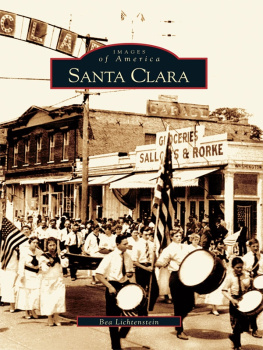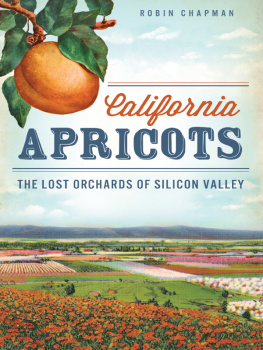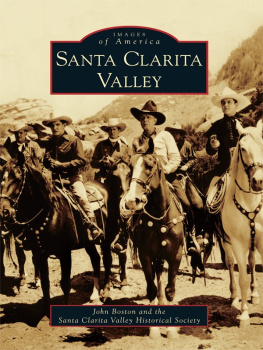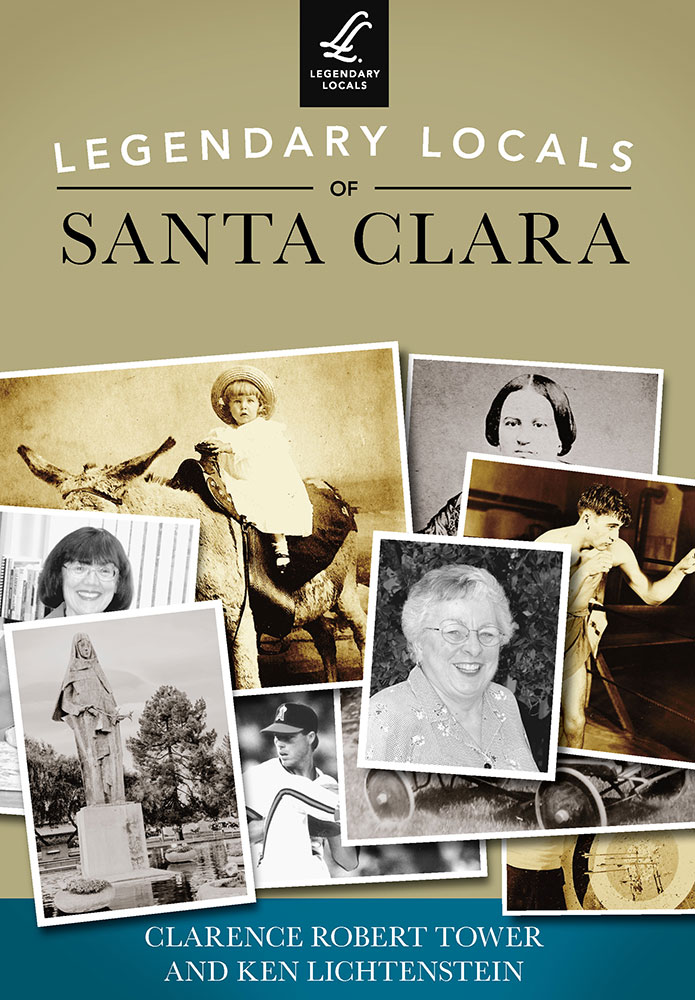
LEGENDARY LOCALS
OF
SANTA CLARA
CALIFORNIA
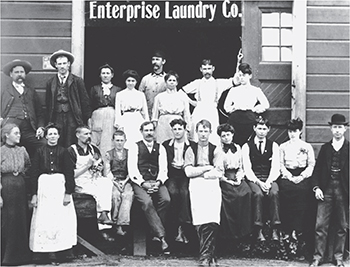
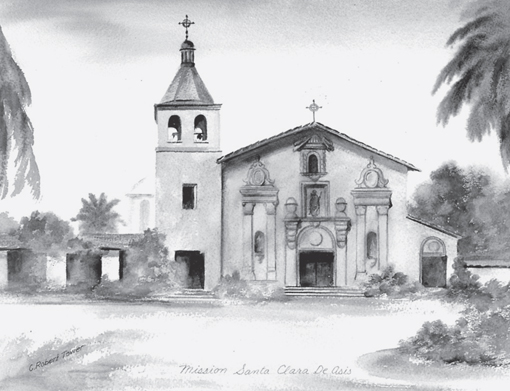
Mission Santa Clara, Cornerstone of the City
The current mission is located in the very heart of the Santa Clara University campus. Although it has occupied this location for approximately 190 years, it was originally founded a short distance north of its current location. A number of earlier structures were lost to the fate of earthquakes and fires. (Courtesy of C.R. Tower.)
Page 1: Enterprise Laundry
This photograph clearly suggests that the city of Santa Clara was a civilized place at the turn of the century. Judging from the size of the staff of the Enterprise Laundry and taking into account their spitand- polish neatness, it is quite apparent that pride in their appearances was a mark of their way of life. (Courtesy of Santa Clara Library.)
LEGENDARY LOCALS
OF
SANTA CLARA
CALIFORNIA
CLARENCE ROBERT TOWER
AND KEN LICHTENSTEIN

Copyright 2014 by Clarence Robert Tower and Ken Lichtenstein
ISBN 978-1-4671-0121-9
Ebook ISBN 9781439642863
Legendary Locals is an imprint of Arcadia Publishing
Charleston, South Carolina
Library of Congress Control Number: 2013945597
For all general information, please contact Arcadia Publishing:
Telephone 843-853-2070
Fax 843-853-0044
E-mail
For customer service and orders:
Toll-Free 1-888-313-2665
Visit us on the Internet at www.arcadiapublishing.com
On the Front Cover: Clockwise from top left:
Frederick Christian Franck III, son of the F.C. Franck II (Courtesy of Lou Faria; see ).
On the Back Cover: From left to right:
Santa Claras 1969 Colt Baseball World Series champions (Courtesy of the Callejon family; see ).
CONTENTS
ACKNOWLEDGMENTS
Although the listed authors will get the written credit for assembling this book, in reality, it was the combined effort of a substantial group of local participants. The list includes current and past members of the Santa Clara City Council, current and former members of the city staff, staff members at the Santa Clara Unified School District, and local supporters of our historic legacy.
Particular thanks go to retired assistant city manager Carol McCarthy, past mayor Larry Marsalli, retired city manager Jennifer Sparacino, and retired parks and recreation director Larry Wolfe for their vital assistance. Special thanks also go to Mary Hanel, local history librarian, and Jashma Kadam, senior staff aid for the City of Santa Clara, for digging out many of the valued photographs and to Nancy Wilson and Lynne Richards for cleaning up the misplaced commas and quotation marks. A thank-you also goes to Karen Brown, office specialist at the parks and recreation department. Thanks also go to former city councilman Kevin Moore for filling in needed information. We are grateful that Lou Faria and Bob Blake allowed the use of their historical collection of photographs. Finally, acknowledgements would not be complete without mentioning the value of the late Bea Lichtenstein collection of historical memorabilia, which accounted for the completion of many of the early pages. Finally, a thank-you goes to Don Callejon for his time spent chauffeuring and to city council member Dominic Caserta for the final overview prior to the manuscript submittal.
INTRODUCTION
The city of Santa Clara lies within the very heart of the Santa Clara Valley, which was once known proudly as the Valley of Hearts Delight. The south end of San Francisco Bay marks its northern boundary. There was a time when a person in the spring could climb the surrounding foothills and witness a sight seen nowhere else on earth. A virtual sea of blossoming fruit trees would lie below. During those years, the valley was known worldwide for supplying the finest apricots, pears, cherries, and prunes, as well as the finest of vegetables. Canneries and fruit packing plants constituted the center of the economy. The croplands prevailed until the end of World War II, at which time a demand for housing began to take priority, and there was good reason. This wonderful valley had the best weather in the world and is only a days drive from some of the most spectacular scenery in the world. A family can hop into a car in the early morning and find themselves in Yosemite, Monterey, Carmel, San Francisco, Santa Cruz, or Lake Tahoe the very same day.
The present-day history of the valley begins in the fall of 1769, when a small band of Spanish soldiers, headed by Don Gaspar de Portol, governor of the Californias, made its way up the Pacific coast from San Diego to find and settle Monterey Bay, the existence of which had been reported by Sebastin Vizcano in 1602. Although it was later determined that they had actually camped on the bays shore, they failed to recognize it.
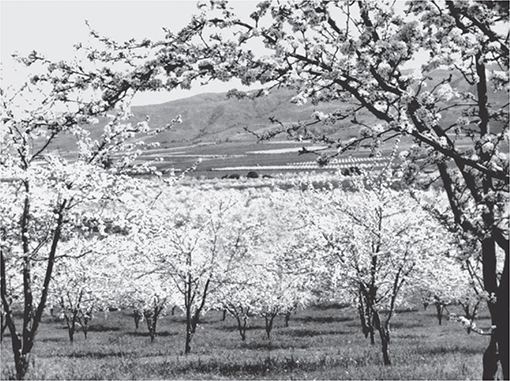
View across the Santa Clara Valley at Blossom Time
Back in time, when the valley was predominantly agricultural, scenes like the one pictured here could be found in all parts of the valley. (Courtesy of C.R. Tower.)
Convinced that it must lie ahead, they continued northward to meet history. Shortly after establishing camp at what is now Pacifica, Don Gaspar de Portol dispatched a party of scouts, led by Sgt. Jos Francisco Ortega, to head east and explore the surroundings. Following Don Gaspar de Portols instructions, they climbed to the nearby crest of the coastal mountains to a point that is now known as Sweeny Ridge. Upon arrival, they would find themselves in a state of astonishment as one of the monumental discoveries of modern history lay below themit was an unrestricted view of the far-reaching expanse of the previously undiscovered San Francisco Bay.
Soon after the bay discovery, the expedition headed southerly and then easterly over the same coastal mountains to establish a temporary camp, within what is now the city of Palo Alto. A tall redwood tree still marks the spot. It is almost certain that their arrival defined the first time the valleys native Ohlone had seen a white man.
Prior to the intrusion of the Portol party, the valley was occupied exclusively by the Ohlone. The population was sparse, consisting only of small villages of dome-shaped dwellings, which were constructed of bent willow branches, covered with mats of thatched tule. The surrounding marshland provided a bountiful supply of fish and fowl. Huge oak trees, spotted throughout the valley, provided a generous supply of acorns. Native grains added to their basic food supply. To this day, an occasional construction project will uncover a stone mortar and pestle the Indians had used to grind their acorns and grains into flour.
During the seven years following the discovery of San Francisco Bay, the lands between Monterey and the San Francisco Bay were routinely traveled. Such travels ultimately included a party of approximately 200 men, women, and children, led by Juan Bautista de Anza. They were dispatched from what is now Southern Arizona, charged with establishing a mission and presidio in San Francisco and with populating the region with Spanish settlers. Mission San Francisco was founded in June 1776. Four months later, Don Fernando de Rivera, the officer in charge of the settlement at San Diego, was ordered to San Francisco to assist with the protection of the mission and presidio. During this trek, a site was chosen alongside the Guadalupe River for the future Mission Santa Clara. In January 1777, he would return to the site, accompanied by Fr. Toms de la Pea, to place a cross near the river and formerly found the site. He would be joined soon thereafter by Fr. Joseph Murguia from San Carlos Mission to more formerly dedicate the mission. This heralded event constituted the ultimate beginning of the city of Santa Clara.
Next page


